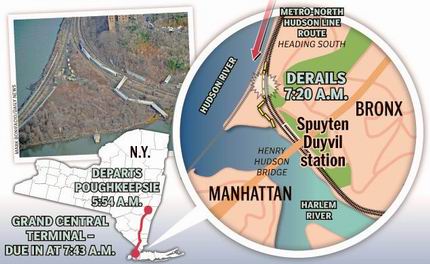
|
|

|
|
| May 11, 2024 |
|
4 dead, 60 hurt in NYC train derailment 
NEW YORK - The 5:54 from Poughkeepsie was rumbling through the Bronx on Sunday morning. Only 100 to 150 people were onboard — department store employees who were bracing for another busy after-Thanksgiving day, tourists from Texas who wanted to climb the Statue of Liberty, a police officer moonlighting as a security guard on his day off.
Some were dozing when the train rounded a bend near where tracks pass under the Henry Hudson Bridge. Some were listening to music on headphones. Suddenly, with a jerk that disrupted the steady train’s steady rhythm, their world turned upside down as they were hurled from one side to the other. In the chaos of screeching metal and the shower of debris as the train kept plowing along, some passengers grabbed for the luggage racks and held on. Others hugged their seats as the eight cars of the train flew off the tracks and several landed on their sides. “I’m thinking I’m going into the water,” said Eddie Russell, 48, who had been listening with his eyes closed to LL Cool J. “I was thinking of me, surviving.” Police and transit officials said four people on board were killed and more than 60 were injured, 11 critically. Three of the four dead were thrown from the train after the windows blew out, the officials said. It was not clear how fast the Metro-North train was going. But an official from the Metropolitan Transportation Authority said the train operator had reported that the train was going into the turn too fast and that he had performed an emergency braking maneuver. The operator told the first rescuers to reach the scene that he had “dumped” the brakes, according to the official, who spoke on the condition of anonymity. Dumping the brakes, railroad experts said, is a last-resort move that has the effect of slamming on the emergency brakes on all the cars of a train at once. It is usually done to avert a collision with another train or a vehicle at a grade-level crossing. Officials opened an investigation but cautioned that it would take time to piece together the evidence and identify a possible cause. The National Transportation Safety Board sent investigators to the site with instructions to inspect the overturned cars and interpret information from the train’s “event recorders,” devices that are somewhat similar to the flight recorders on airplanes. The Federal Railroad Administration also dispatched a team of investigators. (Source: New York Times) Story Date: December 2, 2013
|